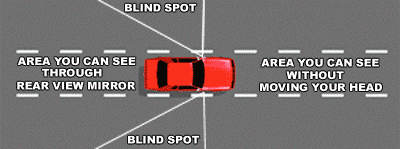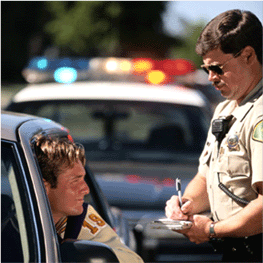Let other drivers know what you plan
to do. By following the suggestions below, you may be
able to avoid an accident.
Keep Your Car
Where It Can Be Seen
The driver's blind spots are shown
in the picture below. The driver cannot see vehicles
in these blind spots when looking only in the mirrors.
The driver must turn his or her head in order to see
a car in one of these blind spots. Drive through another
driver's blind spot as quickly as you can or drop back.
Driver's Blind Spots

Adjusting
Speed
California's "Basic Speed Law"
says that you must never drive faster than is safe for
the current conditions. No matter what the speed limit
sign may say your speed should depend on:
- The number, and speed, of other cars on the road.
- Whether the road surface is smooth, rough, graveled,
wet, dry, wide, or narrow.
- Bicyclists, or pedestrians walking on the edge of
the road.
- The amount of rain, fog, snow, ice, wind, or dust.
For example, if you are driving 45
mph in a 55 mph speed zone during a dense fog, you could
be cited by a police officer for driving "too fast
for conditions."
Remember—Even though you may think
it is safe, you may never legally drive faster than
the posted speed limit.
What Is The
Road Like
The faster the speed, the less control
you have of your car. Rather than just looking at the
legal posted speed limit, you should consider what may
affect the safe operation of your car. For example,
should you drive 35 mph (the posted speed limit) on
a curve down an icy mountain road? Many new drivers
do not slow to safe speeds for each road. That is one
reason why new drivers have more "out-of-control"
accidents than experienced drivers.
Curves
On curves, there is a strong outward
pull on your vehicle especially when the road is slippery.
Rain, mud, snow, or gravel make the road slippery. Sometimes
a speed limit is not posted before a curve on the highway.
You must judge how sharp the curve is and change your
speed, if necessary. Slow down before you enter the
curve. Braking on a curve may cause you to skid.
Water On
The Road
Slow down when there is a lot of water
on the road. In a heavy rain, your tires can lose all
contact with the road at about 50 mph. Your car will
be riding on water or "hydroplaning." A slight
change of direction or a gust of wind could throw your
car into a skid. If your vehicle starts to hydroplane,
slow down gradually—don't apply the brakes.
Slippery
Roads
Slow down at the first sign of rain
on the road. This is when many roads are the most slippery
because oil and dust have not been washed away. If the
road is slippery, it will not give your tires the grip
they need. You must drive more slowly than you would
on a dry road.
Here are some guidelines to help you
adjust speed:
- Wet road—go 5 to 10 miles slower.
- Packed snow—cut speed in half.
- Ice—slow to a crawl.
Some road surfaces are more slippery
than others when wet. These roads usually have warning
signs. Here are some clues to help you spot slippery
roads:
- On cold, wet days, shade from trees or buildings
can hide spots of ice. These areas freeze first and
dry out last..
- Bridges and overpasses tend to freeze before the
rest of the road does. They can hide spots of ice.
- If it starts to rain on a hot day, the pavement
can be very slippery for the first few minutes. Heat
causes oil in the asphalt to come to the surface.
The oil makes the road slippery until it is washed
off.
Driving
In Traffic
Drive slower in heavy traffic because
you have less room. Drive slower so you can stop in
the distance you have.
As a general rule, drive more slowly:
- Shopping centers, parking lots, and downtown areas.
- Roads with heavy traffic.
- When you see brake lights coming on several vehicles
ahead of you.
- Narrow bridges and through tunnels.
- Through toll plazas.
- Near schools, playgrounds, and in residential areas.
How Fast
Is Traffic Moving?
Accidents tend to happen when one driver
is going faster or slower than other cars on the road.
If you are going faster than traffic,
you will have to keep passing other cars. Each time
you pass another car, there is more risk of an accident.
The car you are passing may change lanes suddenly. On
a two-lane road, an oncoming car may appear suddenly.
True, it may not be a big risk, but if you are passing
one car after another, the risks begin to add up. Studies
have shown that speeding does not save more than a few
minutes in an hour's driving.
Going slower than other cars or stopping
all of a sudden can be just as bad as speeding. It tends
to make cars bunch up behind you and it could cause
a rear-end crash. If many cars are pulling out to pass
you, move into the right lane and let them pass.
previous
| table
of contents | next




